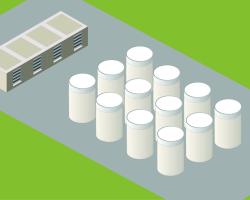Category of Content
Siting Experience Documents Only
Publication Date
Subject Matter
Keywords
Feasibility Study of Direct Disposal of Electrorefining (ER) Salt Waste in a Salt Repository: Laboratory Tests
Feasibility Study of Direct Disposal of Electrorefining (ER) Salt Waste in a Salt Repository: Laboratory Tests
Stability of Intrinsic Pu colloids in the Presence of Montmorillonite at 25 and 80°C: High-fired and freshly prepared PuO2 oxide
Stability of Intrinsic Pu colloids in the Presence of Montmorillonite at 25 and 80°C: High-fired and freshly prepared PuO2 oxide
Update to the Salt R&D Reference Case
Update to the Salt R&D Reference Case
Colloid-Facilitated Radionuclide Transport: Current State of Knowledge from a Nuclear Waste Repository Risk Assessment Perspective
Colloid-Facilitated Radionuclide Transport: Current State of Knowledge from a Nuclear Waste Repository Risk Assessment Perspective
Thermomechanical-Hydrological and Chemical (TMHC) Model Development
Thermomechanical-Hydrological and Chemical (TMHC) Model Development
ADVANCED NUCLEAR FUEL CYCLE EFFECTS ON THE TREATMENT OF UNCERTAINTY IN THE LONG-TERM ASSESSMENT OF GEOLOGIC DISPOSAL SYSTEMS – NATURAL SYSTEM INPUT
ADVANCED NUCLEAR FUEL CYCLE EFFECTS ON THE TREATMENT OF UNCERTAINTY IN THE LONG-TERM ASSESSMENT OF GEOLOGIC DISPOSAL SYSTEMS – NATURAL SYSTEM INPUT
Preliminary Interpretation of a Radionuclide and Colloid Tracer Test in a Granodiorite Shear Zone at the Grimsel Test Site, Switzerland
Preliminary Interpretation of a Radionuclide and Colloid Tracer Test in a Granodiorite Shear Zone at the Grimsel Test Site, Switzerland
Brine Availability Test in Salt (BATS) FY21 Update
Brine Availability Test in Salt (BATS) FY21 Update
Partitioning of Fission Products (Cs, Sr and I) into Salt Phases
Partitioning of Fission Products (Cs, Sr and I) into Salt Phases
Brine Availability Test in Salt (BATS) Extended Plan for Experiments at the Waste Isolation Pilot Plant
Brine Availability Test in Salt (BATS) Extended Plan for Experiments at the Waste Isolation Pilot Plant
Summary of FY15 Results of Benchmark Modeling Activities
Summary of FY15 Results of Benchmark Modeling Activities
Partitioning of Fission Products (Cs, Sr and I) into Salt Phases
Partitioning of Fission Products (Cs, Sr and I) into Salt Phases
Laboratory Experiments on Bentonite Samples: FY15 Progress (S&T Accomplishment Report)
Laboratory Experiments on Bentonite Samples: FY15 Progress (S&T Accomplishment Report)
Modeling Radionuclide Transport in Clays
Modeling Radionuclide Transport in Clays
Diffusion Modeling in a Generic Clay Repository: Impacts of Heterogeneity and Electro-Chemical Process
Diffusion Modeling in a Generic Clay Repository: Impacts of Heterogeneity and Electro-Chemical Process
Mothers for Nuclear Flyer
Mothers for Nuclear Flyer
Mothers for Nuclear Informational Flyer
Socio-technical multi-criteria evaluation of long-term spent nuclear fuel management strategies: A framework and method
Socio-technical multi-criteria evaluation of long-term spent nuclear fuel management strategies: A framework and method
In the absence of a federal geologic repository or consolidated, interim storage in the United States, commercial spent fuel will remain stranded at some 75 sites across the country. Currently, these include 18 “orphaned sites” where spent fuel has been left at decommissioned reactor sites.
Interim Storage, Environmental Justice, and Generational Equity
Interim Storage, Environmental Justice, and Generational Equity
With the termination of the Yucca Mountain project, which was proposed to be our nation’s first repository for the disposal of military and civilian spent nuclear fuel and high-level radioactive waste, the future of nuclear waste management and disposal in this country became increasingly uncertain. Interim storage has been advocated by many as a temporary solution while a permanent solution is studied for potentially several more decades to come.
Interim Storage, Environmental Justice, and Generational Equity
Interim Storage, Environmental Justice, and Generational Equity
With the termination of the Yucca Mountain project, which was proposed to be our nation’s first repository for the disposal of military and civilian spent nuclear fuel and high-level radioactive waste, the future of nuclear waste management and disposal in this country became increasingly uncertain. Interim storage has been advocated by many as a temporary solution while a permanent solution is studied for potentially several more decades to come.
Environmental Risk Characterization Work Plan Yankee Nuclear Power Station Rowe, Massachusetts
Environmental Risk Characterization Work Plan Yankee Nuclear Power Station Rowe, Massachusetts
Radiolytic Specie Generation from Internal Waste Package Criticality
Radiolytic Specie Generation from Internal Waste Package Criticality
Probabilistic External Criticality Evaluation
Probabilistic External Criticality Evaluation
Survey of National Programs for Managing High-Level Radioactive Waste and Spent Nuclear Fuel: 2022 Update
Survey of National Programs for Managing High-Level Radioactive Waste and Spent Nuclear Fuel: 2022 Update
In October 2009, the U.S. Nuclear Waste Technical Review Board (Board or NWTRB) published Survey of National Programs for Managing High-Level Radioactive Waste and Spent Nuclear Fuel. For each of the 13 national programs studied, the report catalogued 15 institutional arrangements that had been set in place and 15 technical approaches that had been taken to design repository systems for the long-term management of high-activity radioactive waste.
Cost Implications of an Interim Storage Facility in the Waste Management System
Cost Implications of an Interim Storage Facility in the Waste Management System
This report provides an evaluation of the cost implications of incorporating a consolidated interim storage facility (ISF) into the waste management system (WMS). Specifically, the impacts of the timing of opening an ISF relative to opening a repository were analyzed to understand the potential effects on total system costs.



